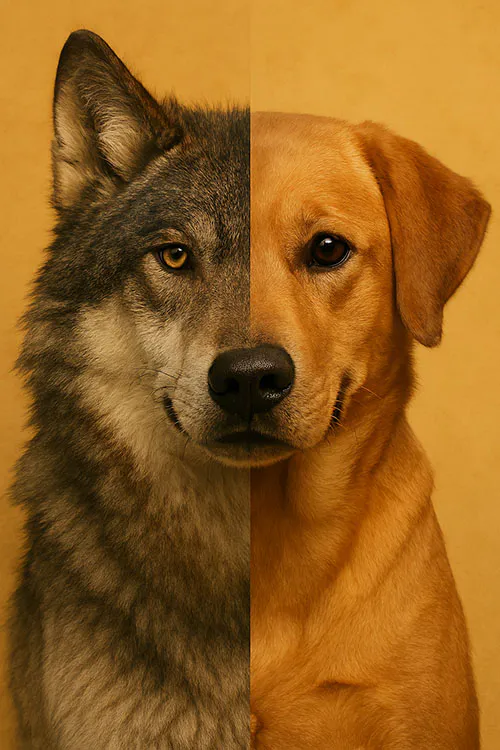
It's widely accepted that domestication occurred in several places and at several times, but when it happened is unclear. Estimates range as from as recently as 8,000 years to as far back as 130,000 years, but the generally accepted time frame is between 20,000 and 40,000 years ago.
This is part two of Wolves. Part 1 is here
Several theories have been proposed to explain how it happened:
Self-Domestication Theory proposes that less fearful wolves began scavenging near human settlements. These wolves gradually became accustomed to human presence, and humans tolerated their presence due to potential benefits (e.g., warning of approaching predators).
Adoption Theory suggests that humans actively adopted wolf pups; raised in human society, these wolves became tamer and more dog-like over generations.
Hunting Partnership Theory posits that humans and wolves formed a mutually beneficial hunting relationship; wolves that cooperated better with humans got more food and protection and so were more successful and passed on their genes.
Protection Theory proposes that wolves served as protectors for human camps, and humans selectively bred the most effective guard animals.
They’re all credible and, in fact, the actual process probably involved all these theories at different times and in different locations. There is also evidence that humans have always taken an interest in and even cared for animals of various types, perhaps because humans have an exaggerated capacity for empathy and can’t ignore an injured or abandoned animal. So, if we put all these things together, we can offer a plausible, general picture of how it happened…
Let’s go back to around 40,000 years ago. Homo neanderthalensis – Neanderthals – would soon be extinct, leaving Homo sapiens as the last surviving Homo species.
These humans were by now exhibiting ‘modern’ behaviours and practices that we recognise, such as establishing settlements, making art, using articulated tools and so on. They started roaming further across the world, and fossil records show that they repeatedly occupied the same territory as wolves.
These wolves and humans, both pack hunters, would have been wary of each other, but inevitably there would have been some contact between them. Over time, wolves that were less aggressive and more tolerant of human proximity would have come nearer to human settlements. Some of these wolves, certainly the less aggressive and probably more curious ones, might even have approached the edges of human encampments, scavenging for scraps of food. Perhaps humans initially drove them off, but it does appear that at some point wolves began to follow human groups as they roamed around hunting.
Eventually, these groups became more accustomed to human presence and perhaps even dependent on them, while humans, recognising the usefulness of the wolves – keeping other predators at bay and alerting humans to potential dangers – began to form bonds with them and to feed them. This mutually beneficial alliance could have been the first step towards domestication.
These wolves came to rely on a reliable source of food, while humans came to rely on wolves as guards, hunters and eventually even companions. It also seems likely that some orphaned wolf cubs were raised by humans.
We can suppose that the more aggressive wolves were gradually driven away from these tamer groups, perhaps by humans or by humans and their ‘friendly’ wolves working together… and this left groups of wolves that were increasingly suited to human companionship. This can arguably be called the first steps in selective breeding, where the traits that made wolves better suited to living with humans – affection, intelligence, lack of aggression – were selected by humans by the simple act of working together, feeding and protecting each other, and these traits were passed down through generations of wolves and magnified, until eventually these animals diverged to become distinct in appearance and behaviour from their wild cousins.
All modern dogs and wolves descended from this now-extinct population: dogs and wolves share this extinct common ancestor that ventured closer and closer to humans and eventually found a home. And at some point, almost certainly by 20,000 years ago, what we now recognise as the first domesticated dogs (perhaps better called ‘proto-dogs’ at this stage), had evolved – distinct from wolves and well established as human companions.
It's important to note that this domestication was not a single event, but multiple domestication events occurring in different wolf populations in different places over millennia. These different groups continued to interbreed with each other and with other groups of wolves and dogs throughout history, with the result that up to 25% of Eurasian wolf genomes show signs of dog ancestry.
But of course, the domestication process didn't end with the rise of dogs as a separate subspecies. As humans spread into new environments, dogs went with them. In Arctic regions, they helped pull loads and locate game under snow. In warmer climates, they assisted in hunting and guarded settlements. The adaptability of dogs meant they could thrive in varied conditions, and their roles diversified as human societies changed. By the time agriculture emerged, dogs were already established as part of human life.
Dogs also developed changes in digestion, allowing them to process starch-rich diets more easily than wolves. Their coat colours and patterns became more varied, and their reproductive cycles shifted. These changes were not planned by early humans but were the result of living closely together. Over time, selective breeding for specific tasks and appearances would refine these traits further.


